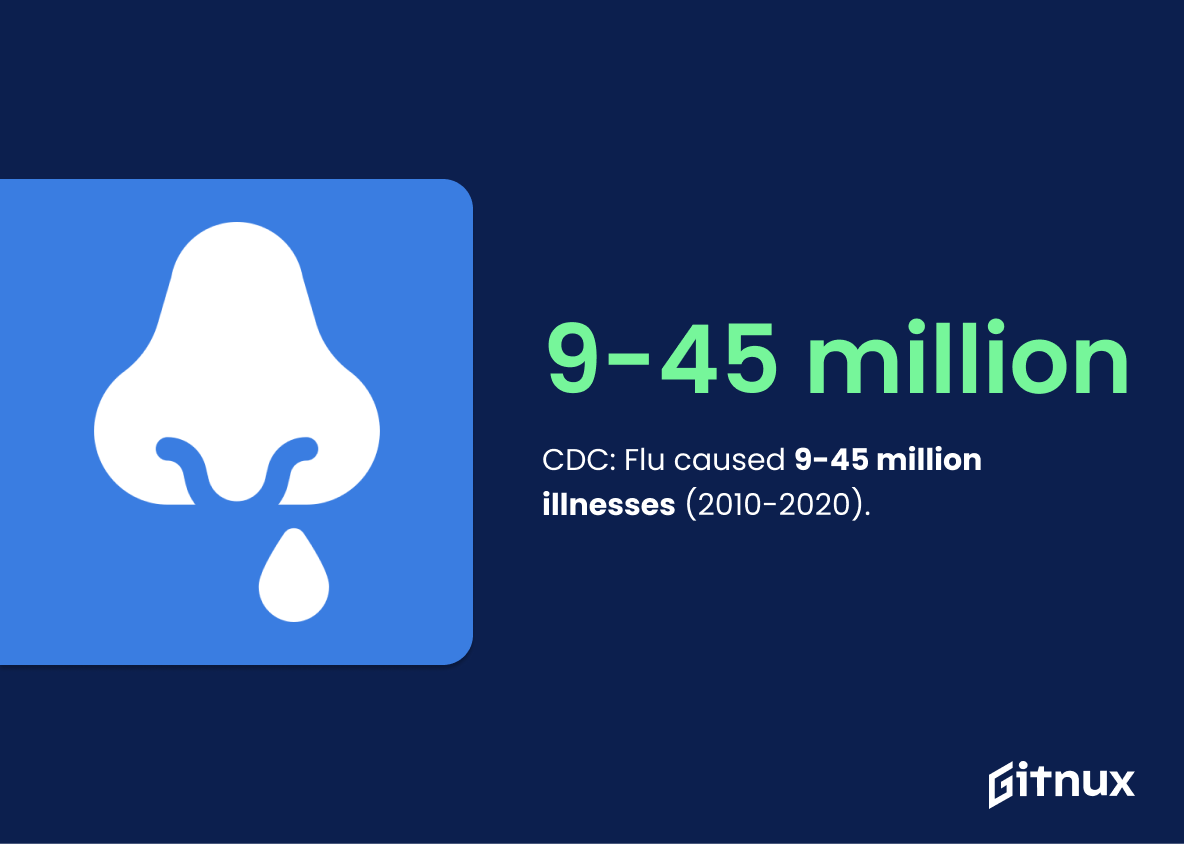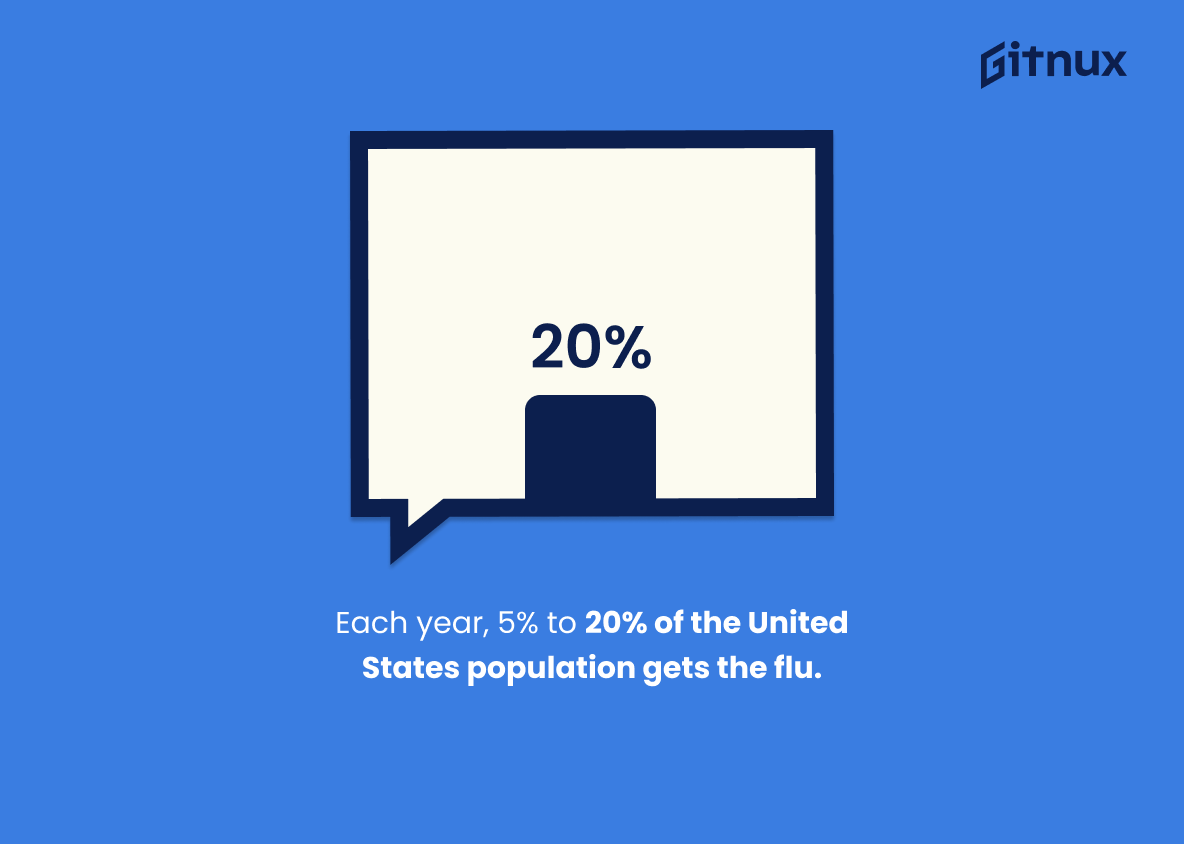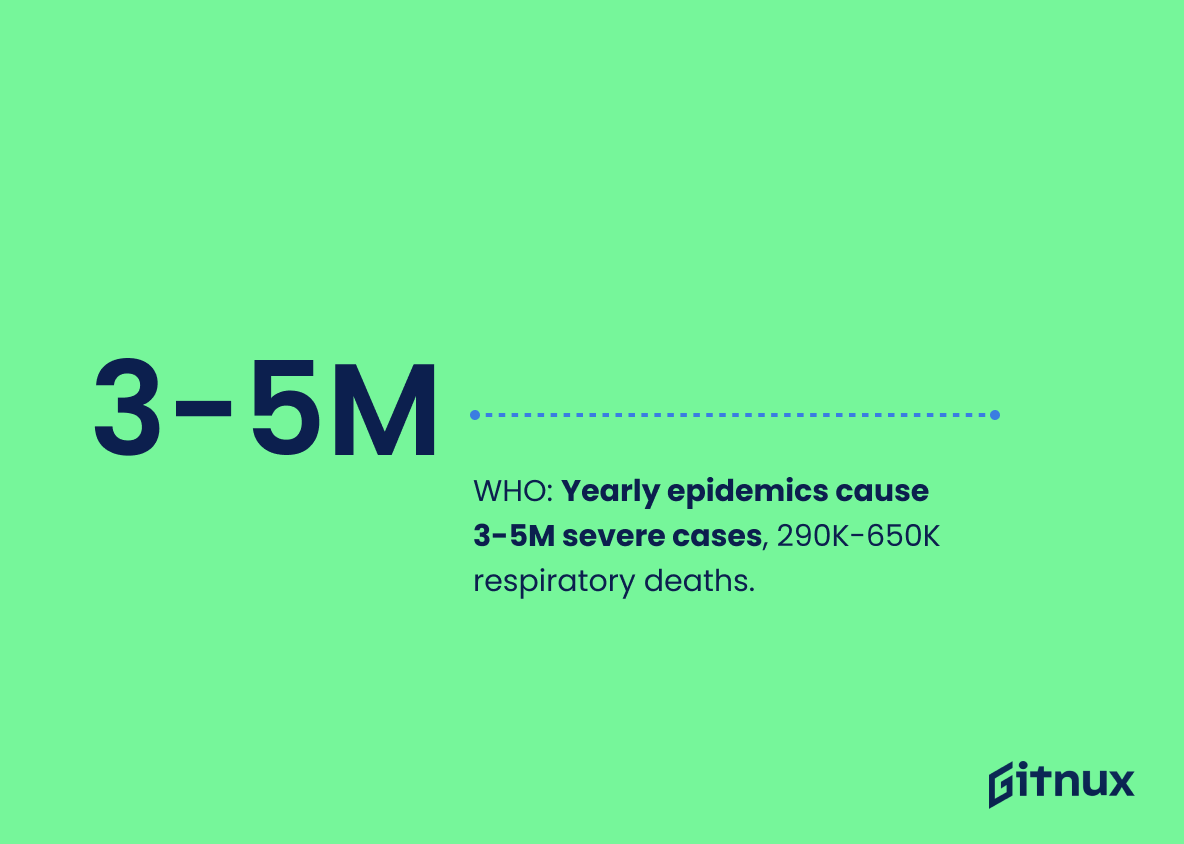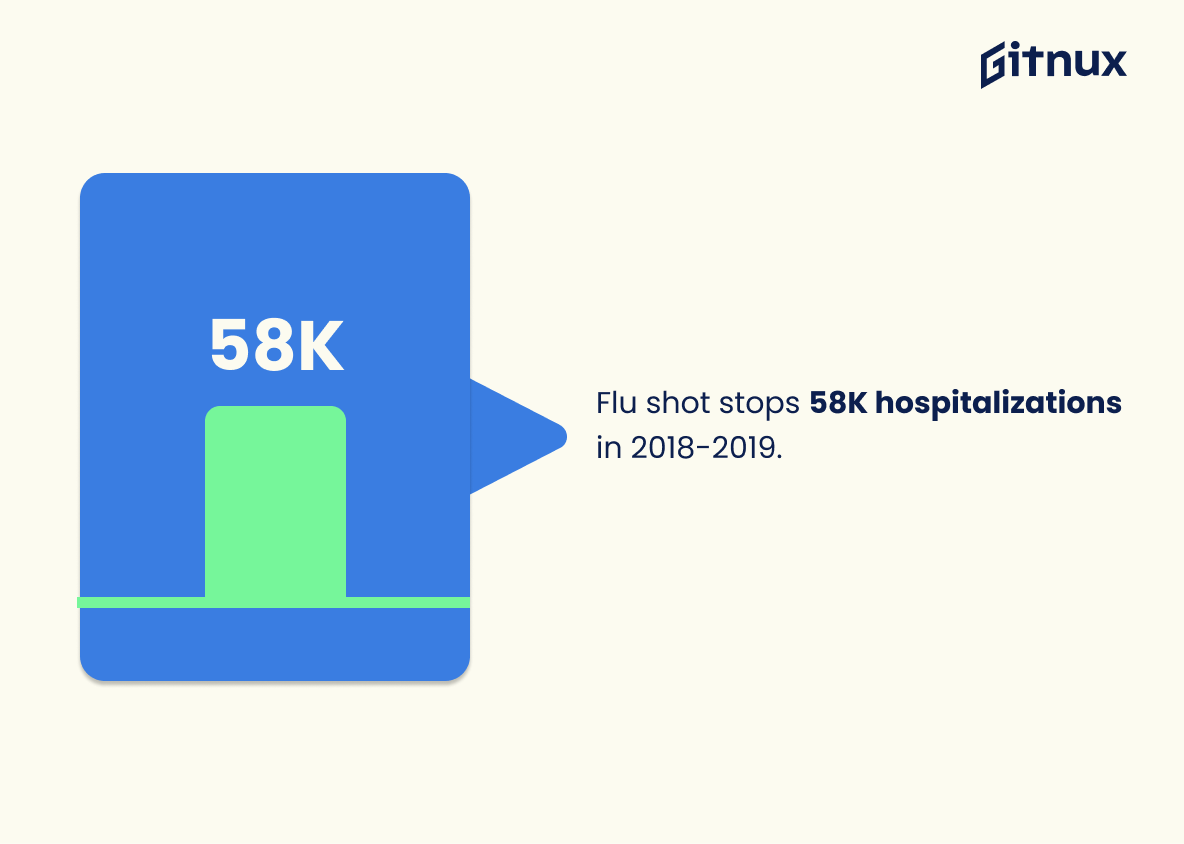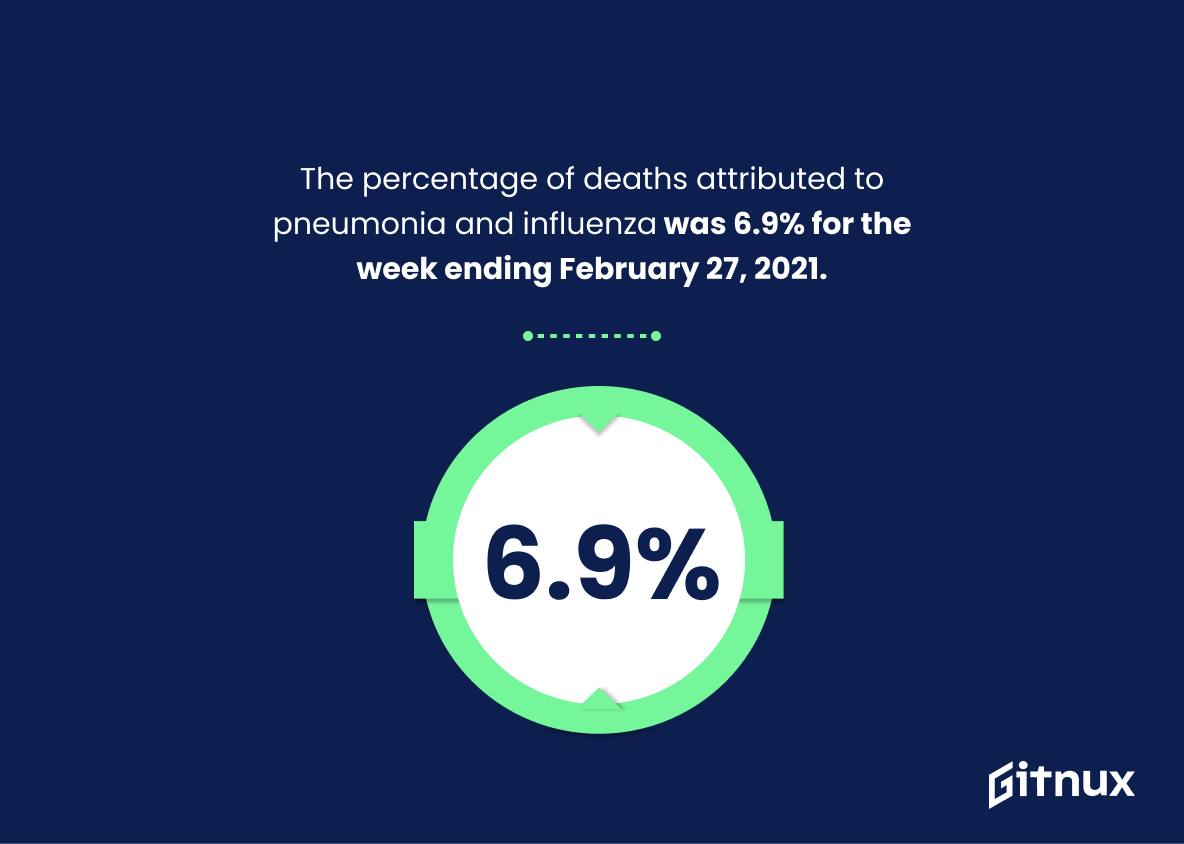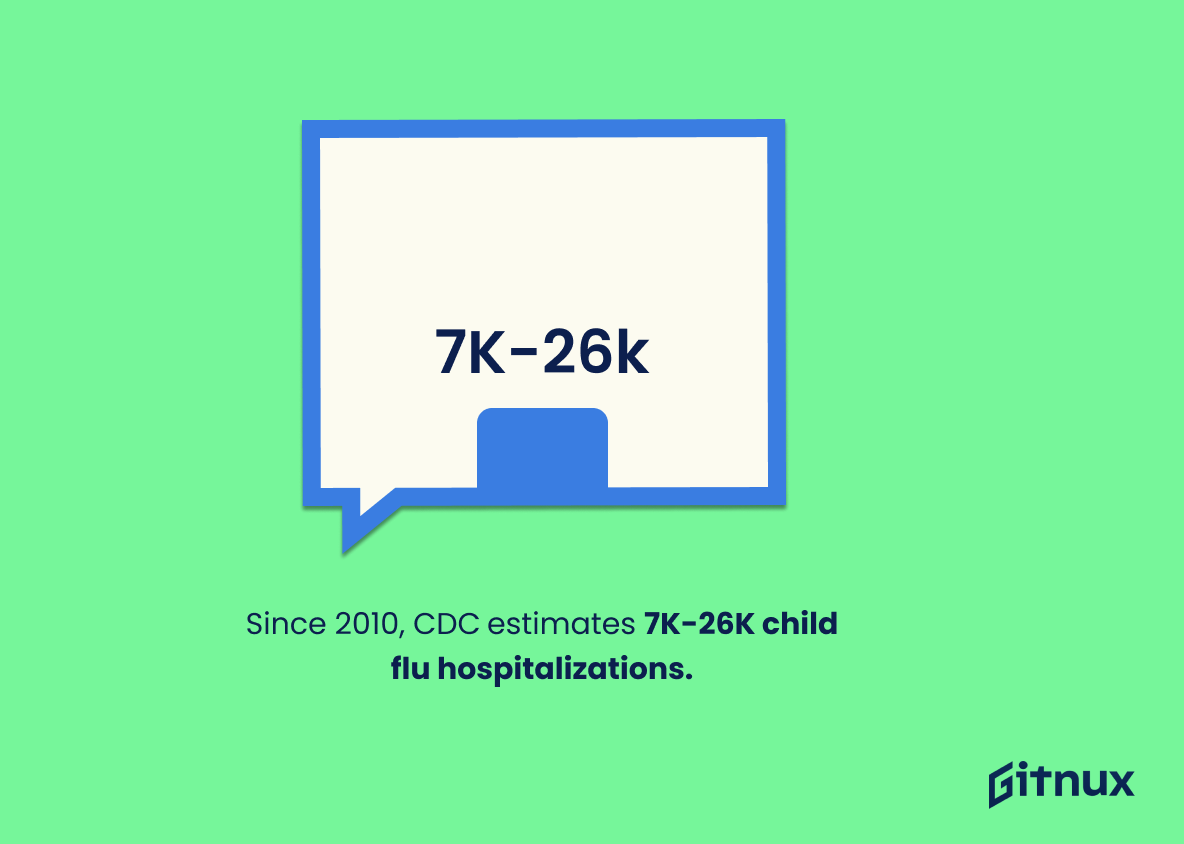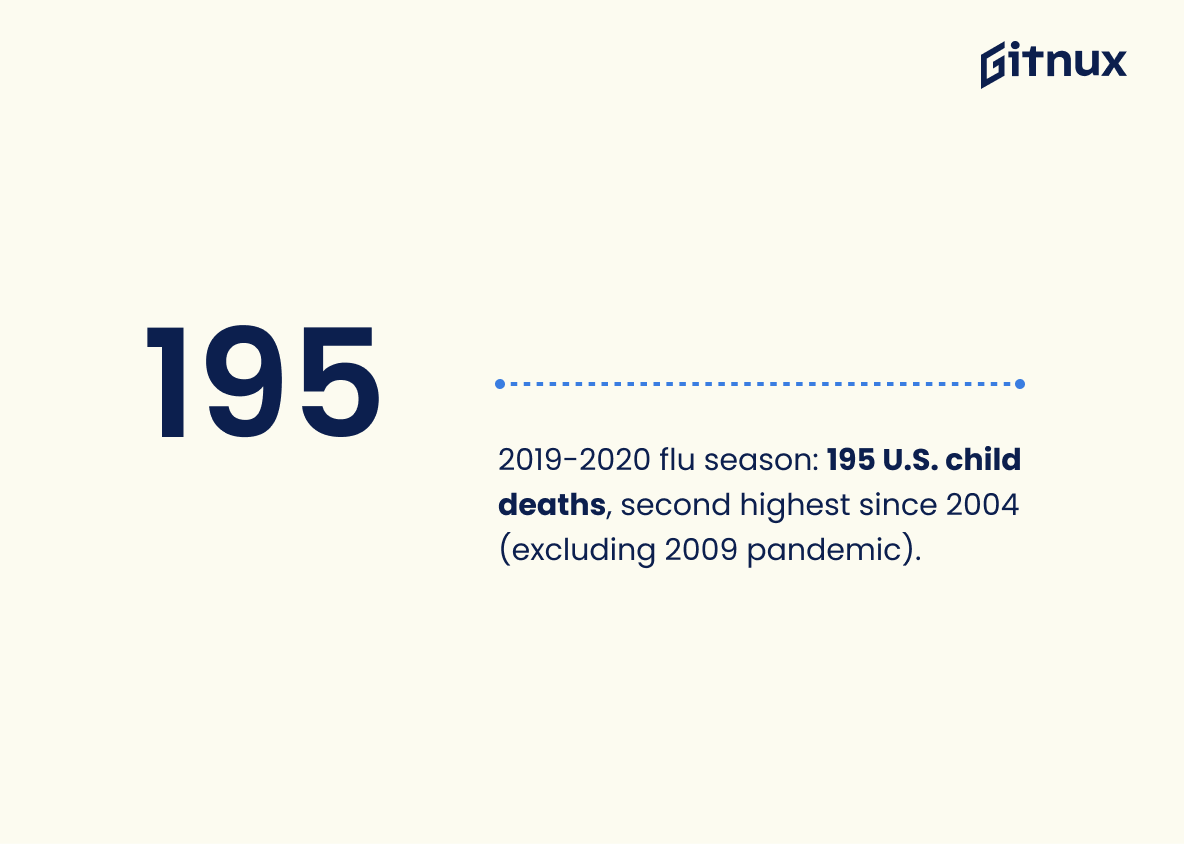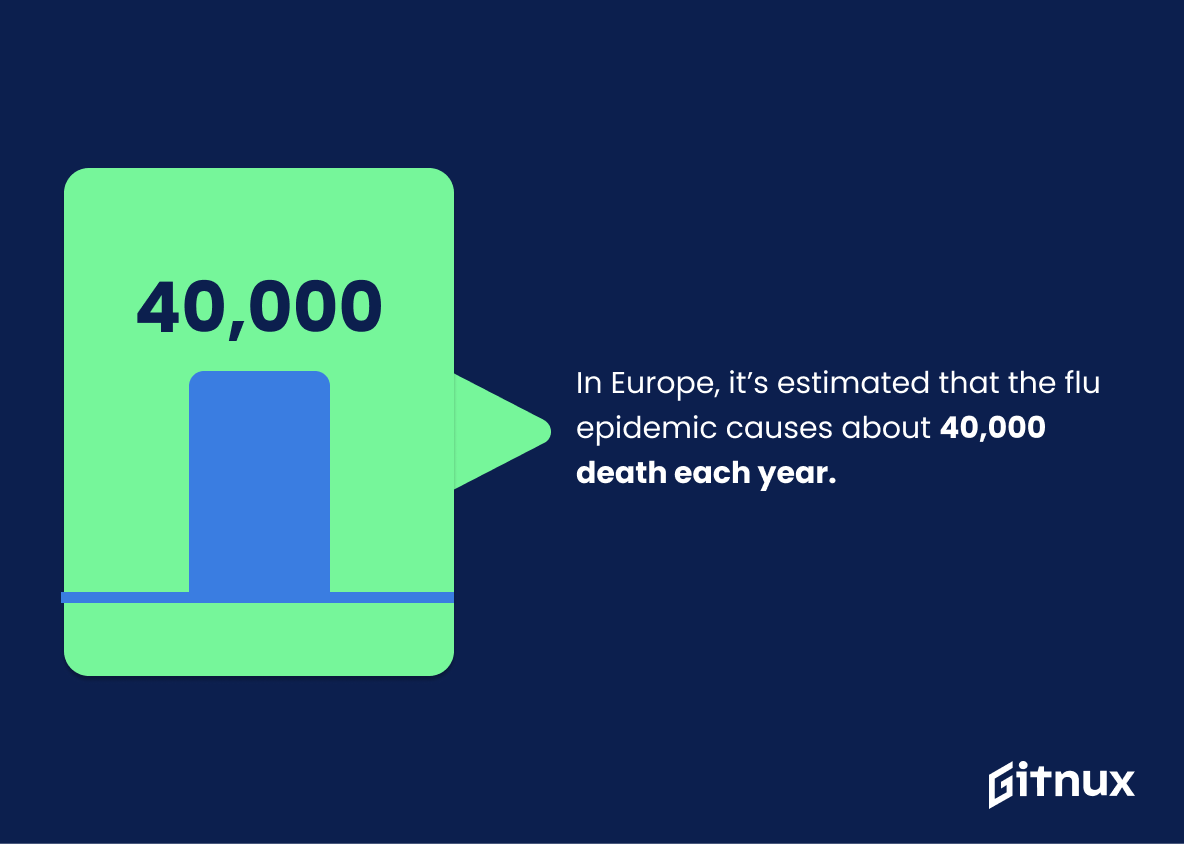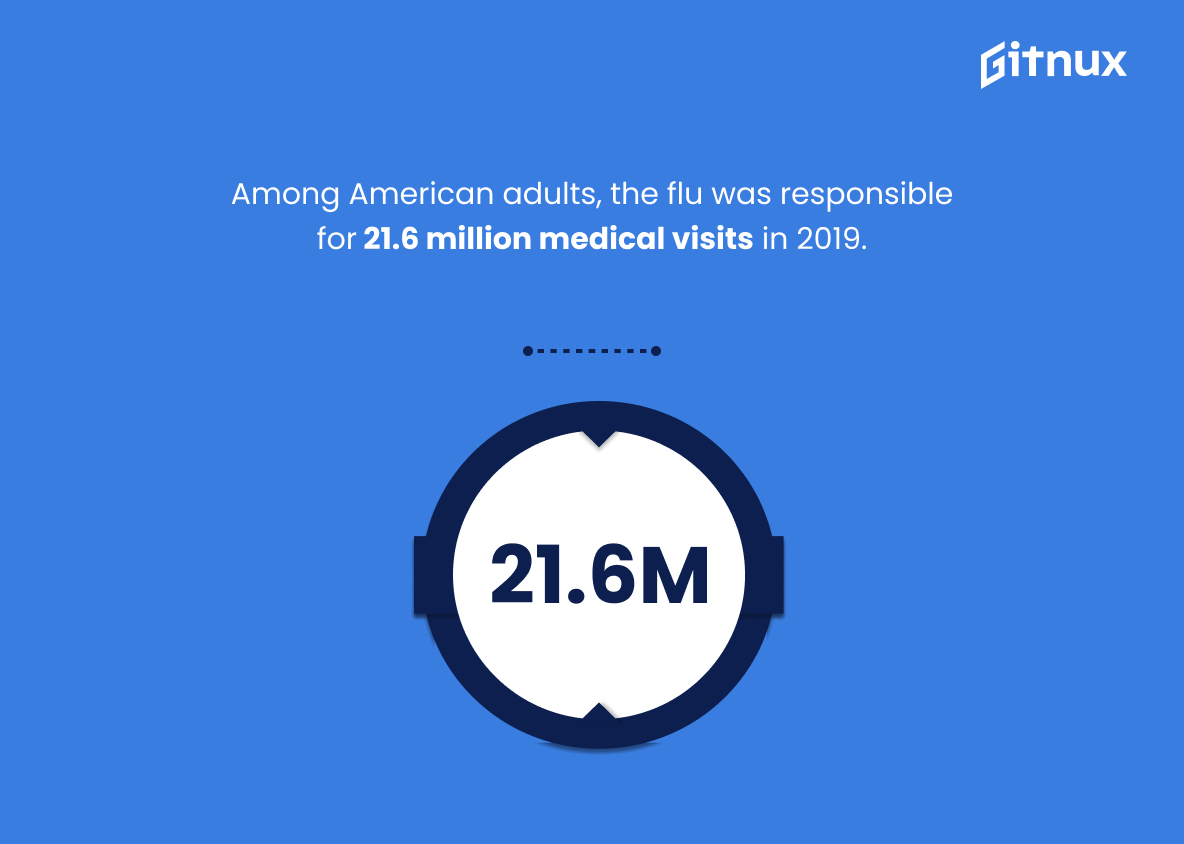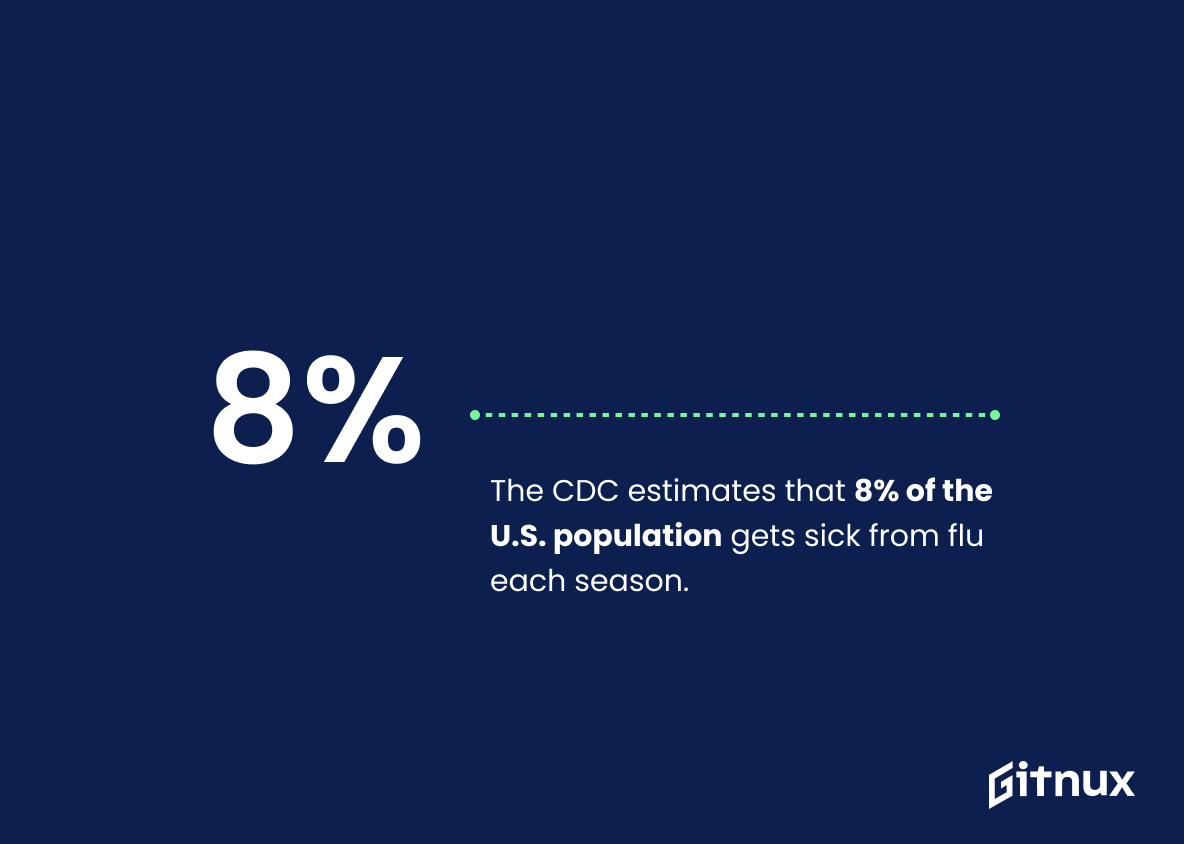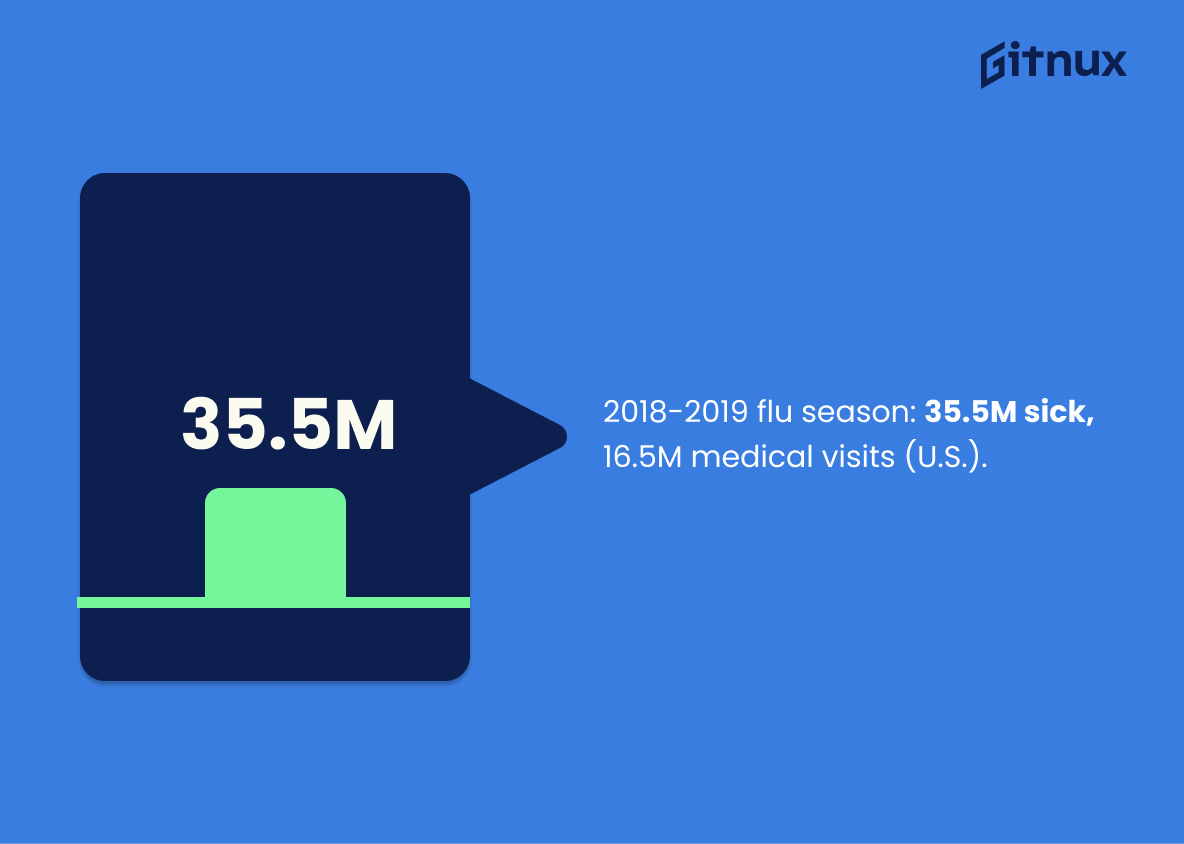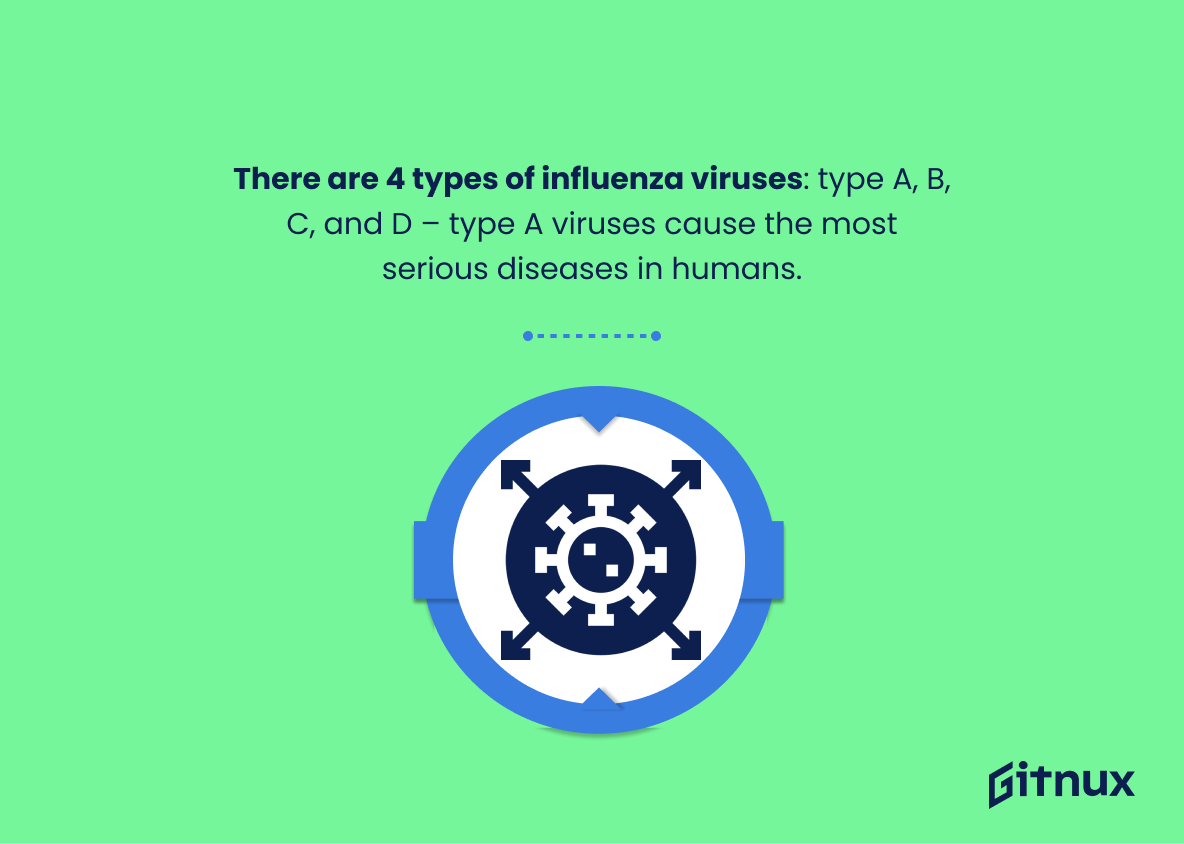Picture this – it’s wintertime and a seemingly harmless sneeze from a passerby could potentially unleash a virus that affects millions globally every year. Yes, we’re talking about the flu. With the constant evolution of influenza viruses, it’s essential to stay updated about the flu statistics for effective prevention and treatment.
This article offers an insightful look into recent data on flu prevalence, patterns, and populations most at risk. Whether you’re a health professional, a concerned individual, or just curious, this deep dive into flu statistics will keep you informed and prepared. Let’s journey through the complicated pathways of this contagious disease, casting light on the shadow of the unknown.
The Latest Flu Statistics Unveiled
The Centers for Disease Control and Prevention (CDC) estimates that influenza has resulted in between 9 million to 45 million illnesses from 2010 to 2020.
Painting a vivid portrait of the rampant reach of influenza, the raw numbers from the Centers for Disease Control and Prevention (CDC) punctuate the story with undeniable severity. The staggering range of 9 million to 45 million illnesses from 2010 to 2020 echoes the invisible yet ubiquitous shadow influenza has cast over the past decade. These figures serve as a barometer, not only indicating the prevalence of influenza, but also helping to fuel preventive measures and awareness campaigns.
In a realm where numbers define reality, these statistics are a poignant reminder of the pervasive nature of the flu, inspiring urgency for continuous research, vaccination efforts and public health strategies to combat future outbreaks.
Each year, 5% to 20% of the United States population gets the flu.
Painting a vivid picture of flu statistics, consider this striking revelation. Each year, a populace ranging from the entire state of Florida to almost all of Texas, illustrating 5% to 20% of the total U.S. population, succumbs to the formidable flu. This striking data is paramount in a blog post about Flu Statistics as it underscores the magnanimity of flu prevalence, suggesting it’s far from just a few isolated incidences.
It further underlines the flu’s potency, potential influence on public health policies, need for preventive measures, and the significance of flu vaccinations in safeguarding public health. By illustrating the potential sea of humanity affected, it lends a considerable weight to the argument for continued research and persistent, proactive responses.
According to WHO, globally annual epidemics are estimated to result in about 3 to 5 million cases of severe illness, and about 290,000 to 650,000 respiratory deaths.
Delving into the realm of influenza statistics, we find ourselves faced with a sobering revelation from the World Health Organization. It unveils to us that each year, worldwide epidemics culminate in roughly 3 to 5 million severe illness cases and claim around 290,000 to 650,000 lives due to respiratory failures. In the mosaic of flu statistics, these figures stand as key pieces, shedding light on the sheer magnitude and grim reality of the situation.
Capturing the true seismic impact of influenza, these statistics become pivotal in understanding the urgency and need for better flu prevention strategies, enhancing healthcare policies, and underlining the significance of flu vaccinations globally. They serve as silent alarm bells, urging us to comprehend the gravity of the situation and prioritize our collective health and well-being.
Flu vaccine prevents tens of thousands of hospitalizations each year. For example, during 2018-2019, flu vaccination prevented an estimated 58,000 flu-related hospitalizations.
Underscoring the compelling narrative of this blog post about Flu Statistics, the given statistic has profound implications. The statement that flu vaccinations prevented around 58,000 related hospitalizations in the 2018-2019 period illuminates the significant role vaccines play in safeguarding public health. The numbers speak for themselves; tens of thousands of people retained their robust health, sidestepping the debilitating effects of influenza thanks to protection conferred by the vaccine.
This fact casts a spotlight on the life-altering potential of readily available medical preventive measures. As such, it’s the cornerstone of a compelling argument endorsing widespread influenza vaccination in the context of our blog post, an essential tool in the arsenal to combat flu proliferation.
The percentage of deaths attributed to pneumonia and influenza was 6.9% for the week ending February 27, 2021.
Setting our eyes upon the compelling statistic – ‘The percentage of deaths attributed to pneumonia and influenza was 6.9% for the week ending February 27, 2021,’ one can perceive its significant implications in the landscape of flu statistics. This striking percentage acts as a stark reminder of the pronounced threat these respiratory illnesses pose to global health.
Served as a timely wake-up call, this data point underlines the profound influence of pneumonia and influenza on mortality rates, substantiating the constant need for proactive health measures and vigilant monitoring of flu trends. Therefore, in a blog post centered on flu statistics, it serves as an alarming yet vital piece of the puzzle, highlighting the severe impact and prevalence of these diseases.
Hospitalization rates are highest among adults 65 and older and children younger than 5.
Unveiling the curtain of Influenza’s theatrical stage, it’s notable how the protagonists are usually adults aged 65 and over, and children younger than 5. Their prevalence in hospitalization statistics sets the tone for a tactful dialogue about flu-related health risks.
Parsing through numbers, it tells a compelling story: Flu, the invisible villain, unleashes its fury disproportionately on these two vulnerable cohorts. Adults over 65 often find themselves in the crosshairs due to weakened immune systems – an inevitable aspect of aging. Conversely, children under 5 are susceptible because their immune systems are still developing and learning to combat threats.
For the audience of a blog post about flu statistics, these unveiling truths reinforce two fundamental strategies for flu prevention. Firstly, the power of vaccination: the flu shot–never a mere footnote, becomes a blockbuster intervention, especially for these higher-risk groups. Secondly, it underscores the importance of community responsibility in flu prevention. The susceptibility of these two groups makes us realize that by protecting ourselves, we shield these high-risk individuals within our communal life.
Bringing these hospitalization rates into laser focus, therefore, steers the narrative of our flu story. It orients our strategies, adjusts our mirrors, and refocuses our preventative actions towards those who are most at risk.
Since 2010, the CDC estimates that flu-related hospitalizations among children younger than 5 ranged from 7,000 to 26,000 in the United States.
Highlighting this impactful statistic provides a vivid picture of the significant toll that the flu can take on children under the age of 5 in the U.S. From this broad range of 7,000 to 26,000 hospitalizations annually since 2010, it’s clear that the flu is not simply a minor ailment in this young demographic.
The fluctuation in the numbers from year to year further underscores the erratic and unpredictable nature of the influenza virus. This statistic acts as a crucial call to arms, seeking to foster proactive preventive measures, including family education and vaccine promotion. It’s a daunting revelation that offers substantial weight to the post, capturing readers’ attention and underlining the post’s necessity in an era where awareness, prevention, and preparedness become more vital.
During the 2019-2020 flu season, 195 children in the U.S. died due to the flu, the highest number of pediatric flu deaths reported since national reporting began in 2004, except for the 2009 pandemic.
Examining the intensity of this data can shed light on two alarming truths. Firstly, it signifies the severity and virulent nature of the flu during the 2019-2020 season. This season witnessed an exceptional toll on our future generation – the children, marking a menacing growth in pediatric flu deaths since national record keeping kicked off in 2004, with the only exception being the formidable 2009 pandemic.
Secondly, this statistic plays as an urgent wake-up call, emphasizing the necessity for early vaccination and other preventive measures, particularly in children. In a flu statistics blog, such facts are critical landmarks that capture the reader’s attention to the pervasive threat of the flu. These help to underscore the need for proactive medical guidance and heightens the appreciation for public health programs targeted at curtailing the flu’s impact.
In Europe, it’s estimated that the flu epidemic causes about 40,000 death each year.
Delving into the stark world of flu statistics, the figure of an estimated 40,000 deaths in Europe annually caused by this seemingly common illness underscores the severity and echo of its impact. It reverberates the critical and relentless nature of the flu, contesting the ubiquitous tendency to downplay its grave consequences.
This swirling vortex of numbers, painted by this statistic, brings a lethal reality into sharp focus. It propels us to acknowledge and confront the implications of the flu epidemic, prompt timely intervention, and advocate stronger health measures throughout Europe, making this an indispensible reference point in any conversation on flu statistics.
Among American adults, the flu was responsible for 21.6 million medical visits in 2019.
Peeling back the layers of this impressive statistic reveals the immense impact of the flu on American adults in 2019, underscoring the footprint of this common yet under-recognized health threat. The reported 21.6 million medical visits shed light on the enormous strains – be it physical, mental or financial – placed on individuals, healthcare systems and the economy.
Moreover, understanding this number offers us a valuable touchstone for measuring the effectiveness of ongoing preventative measures, such as vaccination campaigns, in reducing flu-induced visits. This statistic is a beacon encouraging continued dialogue, research and proactive actions towards flu prevention and treatment.
CDC reports that employees who receive the flu vaccine miss fewer days of work.
The vitality of the aforementioned statistic unveils itself within the canvas of Flu Statistics, underscoring the profound impact of the flu vaccine on workplace efficiency and absenteeism. Highlighting the CDC’s report, it paints a striking portrait of flu vaccination as a formidable shield, not merely against the virus itself, but against the cascading disruption of work dynamics.
Through the lens of statistical storyteller, it becomes an appealing narrative about the unseen fiscal, operational, and human costs pivoting around the axis of vaccine participation. This narrative illuminates the crucial link between immunization, enhanced workforce productivity, and contained absenteeism, thereby reinforcing the urgency of flu vaccination programs in occupational health strategy.
During the 2019-2020 flu season, the flu vaccine was 39% effective in reducing the risk of the flu illness.
Highlighting a stat such as, “In the 2019-2020 flu season, the flu vaccine was 39% effective in reducing the risk of flu illness” illuminates a pivotal health boon for readers delving into flu statistics. It thrusts into light the significant power of vaccination in diminishing disease prevalence, serving as a tangible salute to scientific progress. Furthermore, it underlines the importance of even partial protection, subtly advocating for continued immunization efforts despite not guaranteeing absolute avoidance of illness. It becomes an essential health advocate, communicating the real-life impacts and effectiveness of medical interventions.
The CDC estimates that 8% of the U.S. population gets sick from flu each season.
This CDC forecast serves as a cautionary tale, painting a vivid picture of the extensive reach of the flu virus across the U.S. population. The assertion that 8% of the population falls ill from the flu each season underscores the significance of this public health issue. More than just a number, it’s a stark reminder – an annual rhythm of illness marking the lives of millions.
In the landscape of flu statistics, it helps anchor our understanding of the widespread impact of flu, making it integral information for anyone following the progression and prevention of this seasonal affliction. Such a statistic is a call to action, a pressing invite for everyone to contribute towards combating this annual health menace.
During the 2018-2019 flu season, an estimated 35.5 million people in the United States were sick with the flu and it caused 16.5 million medical visits.
In the theatre of flu statistics, the 2018-2019 flu season serves as a dramatic act, spotlighting the scale of the issue. Imagine stage-filling, 35.5 million-strong crowd bracing themselves against the ailment – a tableau vivant of the flu’s pervasive menace in the United States.
Simultaneously, 16.5 million medical visits become more than numbers – they are a testament to the healthcare system’s formidable task, echoing the profound urgency and importance of prevention, diagnosis, and treatment. This captivating narrative woven through the numbers underscores the significance of vigilance and regular vaccination against the flu in our continued pursuit of public health.
There are 4 types of influenza viruses: type A, B, C, and D – type A viruses cause the most serious diseases in humans.
Diving into the world of flu statistics, this intriguing piece of information – there are 4 types of influenza viruses: type A, B, C, and D, with type A viruses causing the most serious diseases in humans – provides a vivid lens into the complexity and nature of influenza. It sets the stage for appreciating the variance in flu strains, severity and their significant impact on global health.
Furthermore, understanding the role of type A virus in causing the most serious diseases gives clarity and context – contributing to an enriched understanding of why certain flu seasons or pandemics, primarily caused by type A viruses, can be severe and potentially life-threatening. This understanding might lead to discussions around vaccine development, preventive measures, and public health strategies aiming for effective control of influenza, especially type A viruses.
Approximately 43% of Americans received a flu vaccine in the 2019-2020 flu season.
Drawing attention to the fact that in the 2019-2020 flu season, roughly 43% of Americans got vaccinated, heralds a significant illumination on the broader landscape of influenza prevention. By underscoring this number, we lay bare the crucial understanding of how seriously Americans take flu safety measures.
This not only gauges their risk perception, but also shapes the epidemiological pattern of the flu in the country. The percentage illustrates the concern that still exists in terms of the population who remain unvaccinated, painting a vivid picture of the potential for contraction and spread of the disease. Hence, it underpins the urgency of promoting more widespread vaccination.
In Australia, there were more than 310,000 laboratory confirmed cases of the flu in 2019.
This robust figure, pinpointing the number of laboratory-confirmed flu cases in Australia in 2019 at over 310,000, eloquently underlines the pervasiveness of the illness. It is a riveting reminder that no one is immune and that flu is a recurring health challenge with broad societal impact.
It anchors the gravity and scale of the flu issue, offering readers a point of reference that underscores the importance of prevention measures. Equally, this statistic serves as a barometer of health risks associated with flu, while also providing a benchmark to assess the effectiveness of preventive strategies and interventions put in place over time.
According to a study by Imperial College London, the 1918 Spanish flu pandemic infected one third of the world’s population and caused 50 million deaths.
To grasp the magnitude of influenza’s potential havoc, one need look no further than the sobering findings of a study by Imperial College London. This research unearths the horrifying footprint of the 1918 Spanish flu pandemic, which unleashed itself upon an astonishing one third of the global populace and culminated in the tragic loss of 50 million lives.
When embedded within a blog post about Flu Statistics, this piece of data heralds a grim cautionary tale. It’s a stark reminder of the flu virus’ power and impact, underscoring the importance of preventive measures, technological advancements in the field of medicine and the vitality of global health preparedness.
In the UK, over 22 million people have been vaccinated against the flu in the 2019-2020 flu season.
Highlighting the figure of over 22 million people in the UK vaccinated against the flu during the 2019-2020 season provides an intriguing testament to the widespread public health efforts to combat the flu. It subtly underlines the critical role that immunization plays in suppressing the spread of the contagious disease and protecting public health.
Showcasing this monumental figure also spearheads a discussion about societal responsiveness to vaccination initiatives, public health policies effectiveness, and the potential parallels that could be drawn to other vaccination campaigns. This, thus enriches the analytical depth and the contextual understanding of flu trends and impacts for our readers.
Conclusion
In summary, understanding flu statistics is essential for both individuals and healthcare providers to mitigate, manage and control the spread of the disease. By analyzing these statistics, we can recognize trends, identify high-risk groups, and enhance preventative measures accordingly.
It also helps pave the way for advancements in research and development of more effective vaccines. Ultimately, staying informed about the flu through these statistics can equip us all to better handle the annual flu season, helping us to stay healthier and protect our communities.
References
0. – https://www.www.statista.com
1. – https://www.www.webmd.com
2. – https://www.www.health.gov.au
3. – https://www.www.england.nhs.uk
4. – https://www.www.who.int
5. – https://www.ecdc.europa.eu
6. – https://www.www.imperial.ac.uk
7. – https://www.www.cdc.gov
